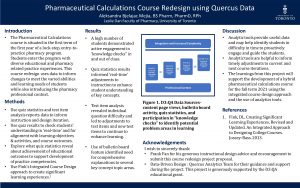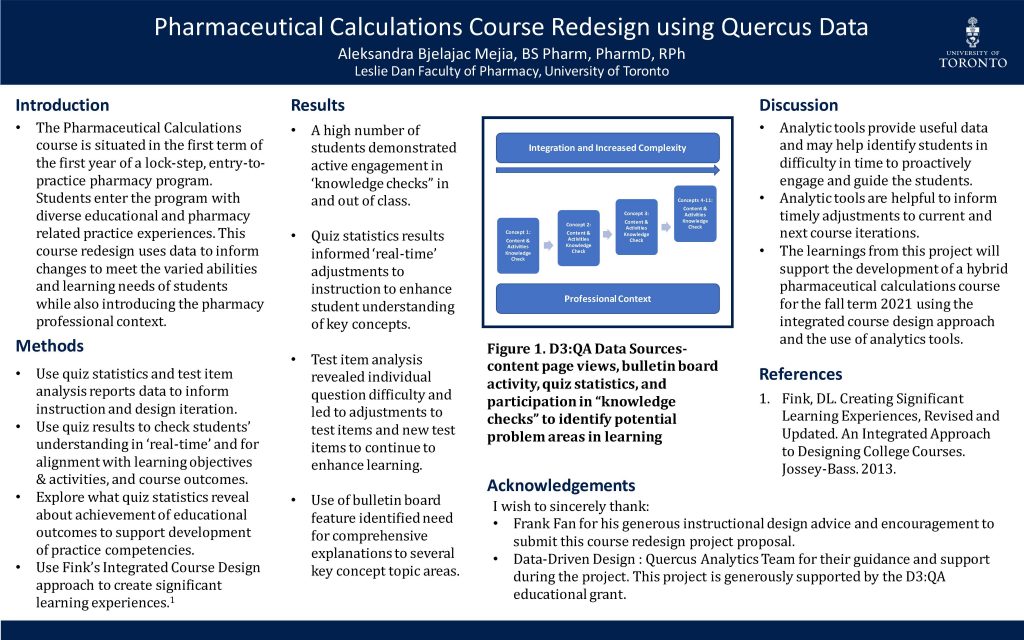Aleksandra Bjelajac Mejia
Course/ProgramPHM130 – Pharmaceutical Calculations |
 Poster and Video Presentation – Teaching and Learning Symposium, May 2021 Poster and Video Presentation – Teaching and Learning Symposium, May 2021 |
Design Context
The Doctor of Pharmacy program, Leslie Dan Faculty of Pharmacy, is a second entry 4-year entry- to-practice program. The Pharmaceutical Calculations course is situated in the first term of the first year of this lock-step program. Students enter the program with varied educational and pharmacy experiences. The term following this foundational course, students are expected to apply pharmaceutical calculations in a practice lab followed by their first experiential rotation in a community practice setting. Pharmacy practice is calculations intensive and accuracy is critically important for safe and effective patient care. Throughout the course, students complete pharmaceutical calculations with a focus on accuracy. Design context to gain a better understanding of how students engage with course materials and “knowledge checks” to enhance student engagement and learning.
Instructional Challenge
In the Pharmaceutical Calculations course, the Quercus quiz feature is used as formative “knowledge checks” to engage students in active ‘in-class’ learning. The goal is to learn about the perceived effectiveness of the use of this quiz feature and other course strategies (e.g. use of bulletin board) through student feedback and instructor experiences. Objective effectiveness will be assessed based on actual use of the tools, quiz statistics, and student performance in the course. The intention is to use data to gain a deeper understanding of how students engage with the course materials and quizzes to make meaningful adjustment to enhance teaching and enhance quiz questions (i.e. determine which questions are working well) to improve the student experience and learning, and decrease frustration with the pace of the course in class (too fast or too slow).
During each lecture, knowledge checks are deployed for students to check their understanding of the material and for the instructor to gauge understanding of key concepts. The results reveal current understanding and allow for ‘real-time’ adjustments/enhancements to teaching concepts/ providing explanations and lead to enhanced opportunities to engage students in meaningful dialogue about the concepts being presented in the lecture. This is especially important as concepts build on each other (increased complexity) throughout the course.
Design Strategy
The course content is arranged in modules 1-11 and two tutorials. The design idea is to transform the course to a hybrid course where a minimum of half the lectures are delivered online and to build an online community of learners supported by the instructor. The quiz feature will be used as assessments for learning to test students’ understanding of the material in real time. These ‘low stakes’ formative assessments will be used to engage students in active learning and is useful to gauge students’ understanding and skill at addressing authentic practice calculations problems. The goal is that students will engage with the material at their own pace and test their progress along the way using the knowledge checks. Use of the data analytics will allow the instructor to assess the test items, assess how students engage with the quizzes with the goal to enhance explanations and deploy examples to assist student learning. It will also allow the instructor to improve the test items to drive learning meeting the diverse needs of the student body. The two one hour in-class tutorials (or virtual on-line tutorials) will still be offered as some students may prefer and benefit from an in-class discussion component to complement their online learning. The goal is to enhance the course by creating engaging learning modules, with embedded knowledge checks, and enhanced detailed explanations for correct responses through the use of audio and video enhancements.
Use of Data to Inform Design Iteration and Instruction
Use of quiz statistics and test item analysis report data to inform design iteration and instruction. Use of formative quiz results to check students’ understanding in ‘real-time’ and for alignment with lecture specific learning objectives, learning activities, and course related outcomes. What do the quiz statistics tell me about achievement of educational outcomes to support development of practice competencies?
Next Steps
Develop new knowledge checks (formative quizzes) to add to the formative quiz bank and explore the use of the ‘new quiz’ feature in Quercus for this purpose. Develop seven brief instructional audio/videos using authentic case examples of common calculations required to practice in community and hospital settings. Plan to embed these within the relevant course module for the Fall 2021 term. Explore the use of a writable tablet and camera to enhance ‘in-class’ explanations. Finally, explore the use of additional ‘new analytics’ data sources to continue to enhance student engagement and leaning through integrated course design.
Poster
Presented at the Teaching and Learning Symposium, May 2021.
Click to download poster PDF in a new tab

